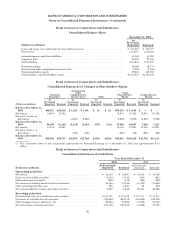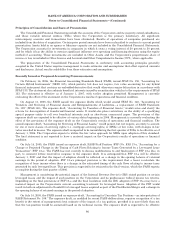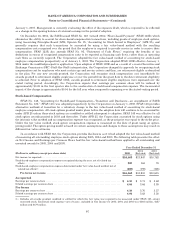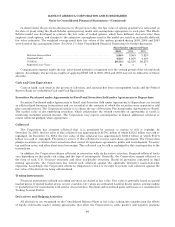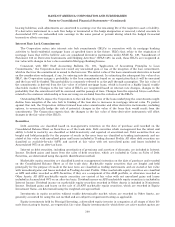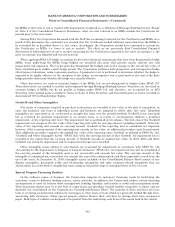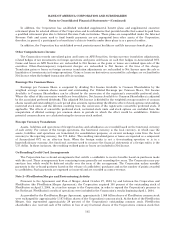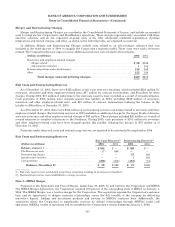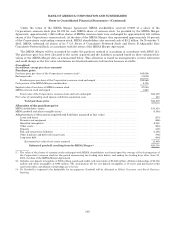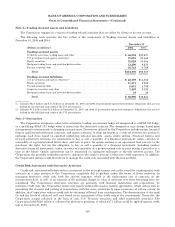Bank of America 2005 Annual Report Download - page 139
Download and view the complete annual report
Please find page 139 of the 2005 Bank of America annual report below. You can navigate through the pages in the report by either clicking on the pages listed below, or by using the keyword search tool below to find specific information within the annual report.BANK OF AMERICA CORPORATION AND SUBSIDIARIES
Notes to Consolidated Financial Statements—(Continued)
the MSRs at the lower of cost or market with impairment recognized as a reduction of Mortgage Banking Income. Except
for Note 9 of the Consolidated Financial Statements, what are now referred to as MSRs include the Certificates for
periods prior to the conversion.
During 2004, the Corporation discussed with the Staff the accounting treatment for the Certificates and MSRs. As a
result of this discussion, the conclusion was reached that the Certificates lacked sufficient separation from the MSRs to
be accounted for as described above (i.e. fair value). Accordingly, the Corporation should have continued to account for
the Certificates as MSRs (i.e. lower of cost or market). The effect on our previously filed Consolidated Financial
Statements of following lower of cost or market accounting for the Certificates compared to fair value accounting (i.e. the
prior accounting) was adjusted and was not material.
When applying SFAS 133 hedge accounting for derivative financial instruments that have been designated to hedge
MSRs, loans underlying the MSRs being hedged are stratified into pools that possess similar interest rate and
prepayment risk exposures. The Corporation has designated the hedged risk as the change in the overall fair value of
these stratified pools within a daily hedge period. The Corporation performs both prospective and retrospective hedge
effectiveness evaluations, using regression analyses. A prospective test is performed to determine whether the hedge is
expected to be highly effective at the inception of the hedge. A retrospective test is performed at the end of the daily
hedge period to determine whether the hedge was actually effective.
Other derivatives are used as economic hedges of the MSRs, but are not designated as hedges under SFAS 133.
These derivatives are marked to market and recognized through Mortgage Banking Income. Securities are also used as
economic hedges of MSRs, but do not qualify as hedges under SFAS 133 and, therefore, are accounted for as AFS
Securities with realized gains recorded in Gains on Sales of Debt Securities and unrealized gains or losses recorded in
Accumulated OCI in Shareholders’ Equity.
Goodwill and Other Intangibles
Net assets of companies acquired in purchase transactions are recorded at fair value at the date of acquisition, as
such, the historical cost basis of individual assets and liabilities are adjusted to reflect their fair value. Identified
intangibles are amortized on an accelerated or straight-line basis over the period benefited. Goodwill is not amortized
but is reviewed for potential impairment on an annual basis, or if events or circumstances indicate a potential
impairment, at the reporting unit level. The impairment test is performed in two phases. The first step of the Goodwill
impairment test compares the fair value of the reporting unit with its carrying amount, including Goodwill. If the fair
value of the reporting unit exceeds its carrying amount, Goodwill of the reporting unit is considered not impaired;
however, if the carrying amount of the reporting unit exceeds its fair value, an additional procedure must be performed.
That additional procedure compares the implied fair value of the reporting unit’s Goodwill (as defined in SFAS No. 142,
“Goodwill and Other Intangible Assets” (SFAS 142)) with the carrying amount of that Goodwill. An impairment loss is
recorded to the extent that the carrying amount of Goodwill exceeds its implied fair value. In 2005, 2004 and 2003,
Goodwill was tested for impairment and no impairment charges were recorded.
Other intangible assets subject to amortization are evaluated for impairment in accordance with SFAS No. 144
“Accounting for the Impairment or Disposal of Long-Lived Assets” (SFAS 144). An impairment loss will be recognized if
the carrying amount of the intangible asset is not recoverable and exceeds fair value. The carrying amount of the
intangible is considered not recoverable if it exceeds the sum of the undiscounted cash flows expected to result from the
use of the asset. At December 31, 2005, intangible assets included on the Consolidated Balance Sheet consist of core
deposit intangibles, purchased credit card relationship intangibles and other customer-related intangibles that are
amortized on an accelerated or straight-line basis using an estimated range of anticipated lives of 6 to 10 years.
Special Purpose Financing Entities
In the ordinary course of business, the Corporation supports its customers’ financing needs by facilitating the
customers’ access to different funding sources, assets and risks. In addition, the Corporation utilizes certain financing
arrangements to meet its balance sheet management, funding, liquidity, and market or credit risk management needs.
These financing entities may be in the form of corporations, partnerships, limited liability companies or trusts, and are
generally not consolidated on the Corporation’s Consolidated Balance Sheet. The majority of these activities are basic
term or revolving securitization vehicles for mortgages or other types of loans which are generally funded through term-
amortizing debt structures. Other special purpose entities finance their activities by issuing short-term commercial
paper. Both types of vehicles are designed to be paid off from the underlying cash flows of the assets held in the vehicle.
103




